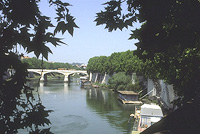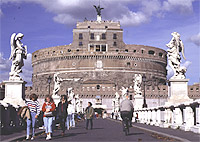River Tiber and Bridges
Ponte Milvio. Still standing.
 A graceful brick and marble construction with a keep built on it.
A graceful brick and marble construction with a keep built on it.
It is important in Catholic history as the place where the first Christian Emperor, Constantine, was converted by a vision of the cross on the eve of the great battle in 312 AD when he deprived the pagan Maxentius of the imperial title.
In the Battle of Ponte Milvio, Maxentius came across this bridge from Rome to fight his enemy, but Constantine's cross-bearing troops seized the bridge, cutting off Maxentius from his base.
 Ponte St. Angelo. Still standing.
Ponte St. Angelo. Still standing.
Emperor Hadrian built a bridge here (137 AD) to cross the river to his Mausoleum (now Castel Sant’ Angelo).
It collapsed in the Holy Year 1450 when the vast crowd panicked. Rebuilt, it was the scene of Beatrice Cenci's execution.
Bernini and his School embellished the bridge with 10 statues of angels (1598-1660).
Ponte Nerone. Destroyed; just 2 stone piers visible at very low tide.
Ponte Sisto. Built by the Romans as Pons Aurelius, it was rebuilt as Ponte Sisto in 1474. This bridge with the donut hole is one of the city's most lovely.
An ancient Roman bridge, from which early Christian martyrs had been hurled into the Tiber, it had fallen down by 792; but it was rebuilt by Pope Sixtus IV for the 1475 Holy Year.
It has been restricted to pedestrians (and pan handlers). The Pope was remembered for his town planning, but during his Pontificate he was better known for his nepotism (his nephews were assumed to be his sons), his wit, and his "infamous pleasures".
The gracious Baroque fountain at the Trastevere end is the little sister of the great "Aqua Paola" visible from the bridge, way up on the Janiculum Hill (from which the best view of Rome). Both were planned by Pope Paul V Borghese.
This one, "Fontana of Piazza Trilussa", was originally at the other end of the bridge and only moved here a hundred years ago with the construction of the embankments.
Pons Fabricius. (62 BC) still standing and in constant use, it joins the left bank to the island, and is not only the oldest but the best preserved. Pope Innocent XI added the parapet in 1679.
Pons Cestius. (30 BC) still standing and in constant use (even cars), it joins the island to the right bank (Trastevere).
Pons Aemelius or Ponte Rotto. First constructed by Aemilius Lepidus and Fulvius Nobilior in 179 BC in wood with stone piers, the top part was remade in stone by Scipio Africanus. It's death knell was dynamite blasting used to make the embankments in the 1880s.
Pons Sublicius. (c. 600 BC) King Ancus Marcius of the Romans on the Palatine and the Etruscans over in Trastevere built this to honor the peace between them, this was after Horatius won the epic battle against the Etruscans. It was near the present Ponte Aventino Sublicio.
TourVisa runs M/S Tiber II twice daily from Umberto I bridge up to Duca d'Aosta bridge and back, without stop, running time 1 1/2 hours. Daily departures at 10,30 am and 12,45 pm (on this mid-day cruise lunch can be served for groups of at least 20).
Lungotevere Tor di Nona, under Umberto I bridge. tel 06 4463481